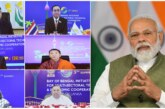Assumption of power by the Maoists in Kathmandu in the aftermath of recent elections has evoked mixed signals in Nepal’s neighbourhood as well as among the Western countries and the United States. The unabated pace of the Maoists insurgency in this small Himalayan country had raised many eyebrows expressing deep concern about the peace and stability of Nepal and South Asia in particular and the world in general at this crucial juncture of intense struggle being waged by the United States and other democratic countries, including India, against the menace of internationalism.
India and China are Nepal’s immediate neighbours and any development in Kathmandu is prone to leave its impact either in New Delhi or Beijing, depending on the nature of event, and vice versa. With the formation of the Maoist government in Kathmandu, many in Delhi are wondering where it leaves relations between the two countries. While India has nurtured some ties with the former rebels, there is growing concern over the Maoists’ links with China, and also with India’s own troubling Maoist insurgency. Reports in the Indian and Nepalese media have quoted Maoist leader Prachanda talking about taking a more ‘balanced’ approach in his country’s dealings with its neighbours stating that he will develop ‘new relations’ with India, he is reported to have said that Nepal will maintain an equal distance between Delhi and Beijing. Observers feel that this comment has already sent policy-makers in Delhi into a tailspin. Since the change of regime in Nepal entails serous repercussions for China and India, it is appropriate to briefly examine China and India factors vis-à-vis Nepal and their impact on each other as well.
CHINA FACTOR
China is a decisive factor in determining Nepal’s foreign policy towards this region in general and India in particular. Nepal’s more than 1,400 km long border with China makes it vulnerable to Chinese machinations. In the past, ruling elite in Kathmandu had frequently made use of ‘China-card’ against India. Nepal is equally of immense strategic significance for China to keep its sphere of influence in South Asia and build pressure on India.
Whenever Nepal had democratically elected governments, China lost the partners in autocratic governance giving way to the democratic countries such as India, the US, the UK and other European democratic governments to have more influence on the elected governments in Nepal than the Chinese Government. Naturally, often the Beijing got sidelined, and found ignored by elected governments in Nepal. The elected governments in Nepal tended to loosen their control over the Tibetan refugees in Nepal, and let them freely travel and engage in their activities for freedom in Tibet. Hence, China always found democracy in Nepal as a threat to their oppressive rule in Tibet.
Whenever Nepal played the China-card, the first victims were the Tibetans fighting for freedom from the autocratic rule of the Chinese leaders, and another victim, of course, was the democracy in Nepal. This was true in 1960 when the former King Mahendra played the China-card to kill the infant democracy, and in 2005 when the present King Gyanendra played the China-card to throttle the flourishing democracy.
When King Prithvi Narayan Shah described ‘Nepal is a yam sandwiched between two large stones’, he was referring to India to the south and China to the north as two large stones, and Nepal as a yam in between them. He left his advice to his future generations to follow the policy of not aligning with only one side – either to the north or to the south in other words to achieve a good balance between them. In balancing between the two powerful countries – one to the south and another to the north, the rulers of Nepal had sometimes played one against another when the situation favorable to do so arose.
Pursuant to the Nepal-India Treaty of 1950, Nepal needs to consult with India to import arms and ammunition from the third party country. At that time, Nepal and India had this treaty done to cater the needs for countering the threat from the People’s Republic of China that had captured Tibet by force in 1949. Pursuant to this treaty, India could halt or check any arms and ammunition passing through its territory to Nepal. India did not have any means to check the arms supply to Nepal by China if they came from China to Nepal through Tibet.
Nepal could not receive weapons from Pakistan despite Pakistan’s strong desire to supply weapons to Nepal after India, the US and the UK had suspended arms supply to Nepal since February 2005. During 2005, the Nepali ruling elite desperately sought arms from China, and received 18 truckloads of arms and ammunition from it. According to media reports, the Chinese army escorted eighteen trucks carrying arms and ammunition to Nepal’s border where plain-clothes Nepalese troops took over in November 2005. The continuing Chinese arms supply to Kathmandu was more than a tactical threat to India’s attempt at promoting democracy and stability in Nepal.
India’s call on China to stop supplying arms and ammunition to Nepal and join international efforts to force King Gyanendra to restore democracy following his takeover in February 2005 was almost ignored.
Past couple of years have witnessed spurt in China’s activities in various aspects of the Nepalese life. Chinese People’s Association for Friendship with Foreign Countries (CPAFFC) and Nepal-China Executives Council (NCEC) signed a Memorandum of understanding (MoU) on 25 December 2005. According to the MoU, both the CPAFFC and the NCEC shall cooperate on the promotion and expansion of cooperation in the field of trade, tourism and cultural exchanges, and shall act as facilitators to promote and strengthen investment and entrepreneurial relationship between Nepal and China.
On 3 January 2006, Xinhuanet reported that the Chinese Ambassador to Nepal said that China accorded a high priority to the construction of the proposed Koshi-Lhasa Highway linking Nepal’s eastern zones with China’s Tibet Autonomous Region. At an interaction program held by the Morang Trade Association, Chinese Ambassador to Nepal, Sun Heping said, “We have given this highway a high priority. Among the 10 highways that link Nepal with China, this was the most important highway. However, the Nepali Government needed to request the Chinese authorities officially for the construction of the highway.” In addition, the Chinese Ambassador to Nepal said that the request to open a Consulate General’s Office in Biratnagar could be considered after consultations with the government.
India communicated its strong displeasure to Kathmandu in view of the reports that the latter was toying with a plan to let China and Pakistan open consulates in the sensitive Indo-Nepal border areas. China is apparently ready to open a consulate at Biratnagar at the border between eastern Nepal and Bihar. Pakistan, not to be left behind, is keen to open shop at Birganj in central Nepal region that also borders Bihar.
China plans to build a railway line from Lhasa to Xigaze, the region’s second largest city located at an altitude of about 3,800 meters and some 270 kilometers from Lhasa. The project is expected to take three years. Currently, land transportation between Tibet and neighboring Nepal and India is not easy. Nyalam located in Xigaze is the only border crossing that boasts a highway.
At the outset of the third week of March 2008, as tales and images of a violent Chinese crackdown in the Tibet region began pouring out, Nepal began expressing public support for the communist republic and airing the Chinese government’s point of view to scale down the protests. Nepal’s official media projected the Chinese version of the demonstrations in Lhasa, capital of Tibet Autonomous Region, and its neighbouring provinces.
With Nepal-China relations already so strategically placed, coming into power of the Maoists provides further leverage to Beijing in the corridors of power in Kathmandu vis-à-vis India. Keeping in view the long term strategy of Beijing, the Nepal Maoists can play pivotal role in help fulfill China’s objectives and in that eventuality India would be encircled from Nepal’s side by China.
INDIA FACTOR
There are speculations about the Maoists using their new-found electoral clout as leverage over India. KV Rajan, a former Indian ambassador to Nepal, has expressed his apprehensions thus: “It means that the special relationship between India and Nepal which dates back to British days and 1950 is in its terminal phase.” A Treaty of Peace and Friendship, which both countries signed in 1950, defined their political and economic relationship. Under the Treaty, people living in both countries could freely travel across the border for employment, and could reside in either place.
It also granted preferential trade arrangements and, until 1969, allowed India to maintain security posts in Nepal’s northern border with China, as well as a military mission in Kathmandu. India’s basic concern in Nepal has always been China and New Delhi is paranoid about China establishing a major presence in Kathmandu.
The avowed objective of the 1950 treaty was basically to help address India’s security concerns and in return, Nepal got economic benefits, such as the right to live and work in India. But increasingly, many Nepalese were uncomfortable with the Treaty, believing it gave India major political and economic influence. The Maoists have regularly raised the issue and said they want the Treaty scrapped. They also want a review of other agreements, especially those relating to river water and irrigation – issues which are very sensitive on both sides of the border. And there is the question of links between the Maoists in Nepal and those in India.
The gory Maoist insurgency runs in India across a broad swathe of its territory from its northern border with Nepal down to its central tribal belt and the southern state of Andhra Pradesh. It seems to be as the nation’s single biggest security threat. Strategic experts mince no words in expressing the apprehension that the Maoist victory in Nepal will come as a big morale booster to Maoist rebels fighting in India.
Keeping in view the new ground realities taking place in Nepal and changing stance in China’s position on perennial issues affecting Sino-Indian relations, New Delhi can no longer afford to ignore the writing on the wall. There is a need for New Delhi to redefine its relations with Nepal by calling spade a spade. In the past, India’s relationship with Nepal was one between a sovereign country and a semi-protectorate, which now needs to be one of equals.
When many voices have been raised about revision of the old treaty in the recent past, then India should also respond to cater to new demands and requirements that govern relations between two sovereign nations. While ending the special provisions, visa system should be introduced. In recent years, Nepal has become a nerve centre of the activities of the ISI and outlawed militant outfits of India’s North-east. To stem the tide of militants and fake currency pouring into India, it is essential to redefine the treaty terms in consonance with India’s security needs.
China’s growing influence in Nepal is a part of Beijing’s grand strategy to encircle India from Tibet, Nepal, Pakistan and Myanmar sides. China has already expanded its tentacles in all these areas by hook or crook, particularly in the sensitive areas bordering India. In the wake of these developments, one should listen to the sane advice of Commodore C. Uday Bhaskar, Deputy Director of the New Delhi-based Institute for Defense Studies and Analyses, when he says: “India should mount a wholehearted politico-military initiative to ensure that Nepal’s military orientation remains with India. There is a strategic dimension to India’s relationship with Nepal and it has to be handled carefully.”
By Dr. Arvind Kumar, President India Water Foundation



